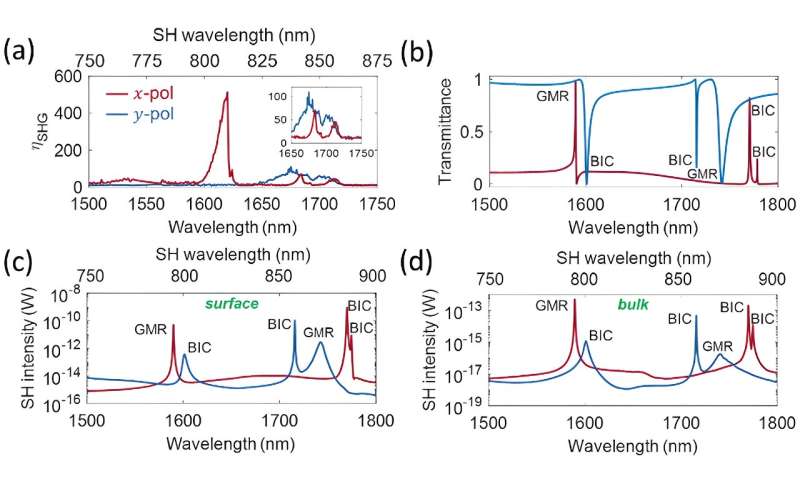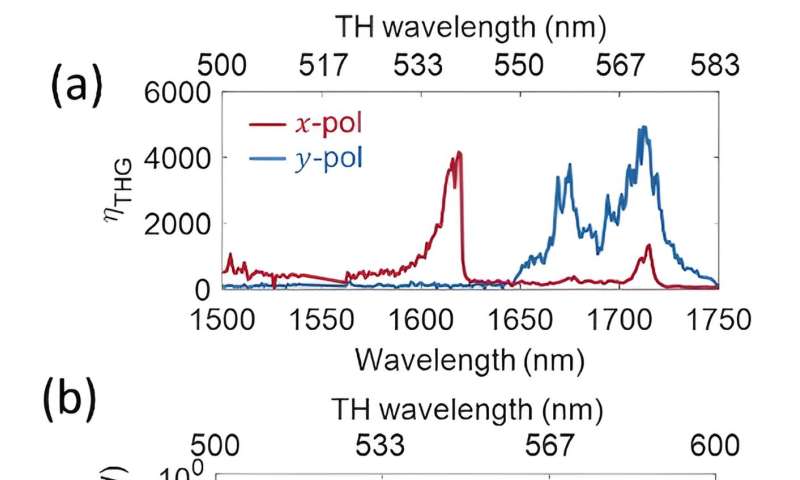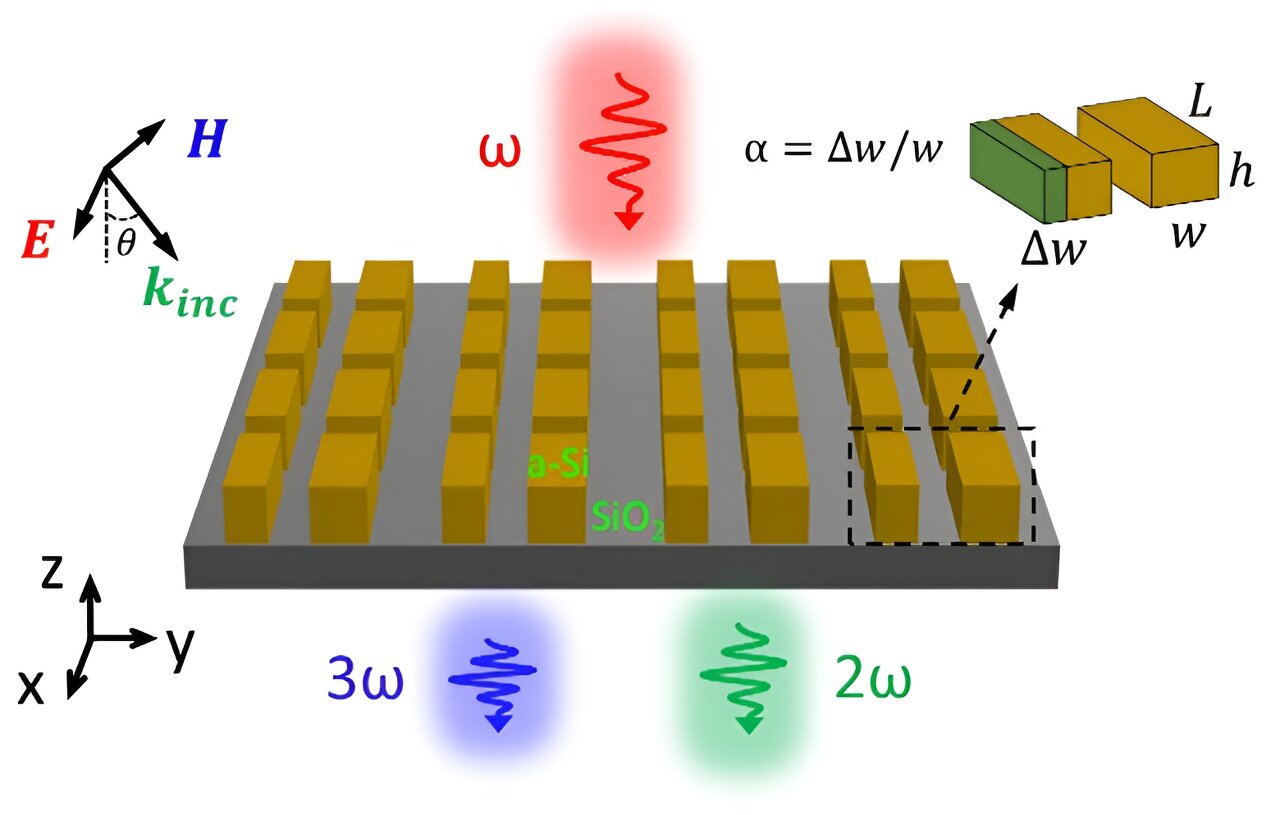Nonlinear optics is a branch of optics that deals with the complex nonlinear relationships between the optical response of the medium and the incident light when it interacts with the optical medium. Currently, nonlinear optics has been successfully applied to a variety of fields, such as laser modulation, optical signal processing, and medical imaging.
In recent years, due to considerations including phase matching conditions in frequency conversion processes and advances in nanofabrication techniques, metasurfaces have become an increasingly important platform for the research and implementation of novel nonlinear optical functionalities.
Generally speaking, optical metasurfaces are ultra-thin artificial surfaces with periodic arrangement at sub-wavelength scale of basic optical elements.
By precisely designing the periodic unit cell, metasurfaces are capable of manipulating the intensity, polarization, and phase of optical waves in unprecedented ways.
In nonlinear optics, metasurfaces also play a significant role because of the powerful control over the intensity of light-matter interaction, the versatile modulation of the phase and polarization of nonlinear optical signals, high degree of design flexibility in terms of geometry and material composition, and potential for seamless integration into compact optical devices.
Recently, researchers have shown that optically resonant all-dielectric metasurfaces based on guided mode resonances make it possible to achieve large quality-(Q) factor resonant effects and enable effective optical elements in applications, such as sensing and harmonic generation.
However, unlike the case of guided modes of photonic crystal slab waveguides, guided mode resonances can couple to the radiation continuum, so that optical energy is lost into the free space. Moreover, a recently revealed physical mechanism, namely bound states in the continuum, provides a new way to achieve strong coupling between light and matter.
Generally, bound states in the continuum possess infinitely large radiative Q-factor. Due to surface roughness, material losses, fabrication imperfections, and other perturbations, bound states in the continuum in practical devices manifest themselves as high-Q resonances with finite Q-factors.
Importantly, the dependence of the Q-factor of BICs on the geometric asymmetry of meta-atoms allows for flexibility in the design of metasurfaces supporting high-Q resonances and an effective control of the strength of light-matter interaction within a wide spectral range.
Spurred by these ideas, BICs have been intensively studied not only in linear optics applications, including vortex beam generation and light guiding photonic devices, but also in relation to a plethora of nonlinear optical effects, such as giant harmonic generation and self-action effects.
Metasurfaces provide a promising platform for the study of nonlinear optics. However, most proposed nonlinear metasurfaces only focused on a single frequency conversion process and lack an efficient way to control and adjust the intensity of the nonlinear optical interactions.
On the other hand, the physical mechanism to achieve local field enhancement is also a key factor in achieving effective frequency conversion.
Research in recent years has shown that enhanced harmonic generation is facilitated by high-Q resonances, which can be realized via bound states in the continuum, yet few studies have investigated guided mode resonances and bound states in the continuum in the same optical device and provided in-depth analysis of different optical processes in both linear and nonlinear regimes.
In a paper published in Opto-Electronic Advances, the authors report on an all-dielectric nonlinear metasurface for giant enhancement of second-order and third-order nonlinear optical response, induced by guided mode resonance and bound states in the continuum.
In particular, the authors took advantage of the rich physics of optical guided mode resonances and bound states in the continuum to generate high-Q resonant spectral features. To this end, by breaking the structural symmetry of a metasurface composed of centrosymmetric amorphous silicon, bound states in the continuum are transformed into quasi bound states in the continuum, thus allowing the coupling between these resonant states and the radiative continuum.
Under these conditions, the high-intensity light-matter interaction caused by existence of resonances at the fundamental frequency give rise to enhanced nonlinear optical polarization at the second- and third-harmonic, which produces enhanced second- and third-harmonic optical beams emitted from the amorphous silicon resonators.
The proposed nonlinear metasurface is comprehensively studied using theoretical techniques, numerical simulations, and experimental measurements. In the numerical calculations, the quantitative analysis of second-harmonic generation takes both surface and bulk effects into consideration, whereas the nonlinear optical beams are assumed to be generated in the bulk of silicon elements.
Next, optical resonances with high Q-factors arising from guided mode resonances and bound states in the continuum at the fundamental frequency were observed and measured an enhancement of the second harmonic generation of approximately 550 times at the second harmonic and an enhancement of the third harmonic intensity of nearly 5,000 times.
-

Experimentally measured second-order nonlinear enhancement factor and the corresponding numerical calculation results. Credit: Opto-Electronic Advances (2024). DOI: 10.29026/oea.2024.230186
-

Experimentally measured third-order nonlinear enhancement factor and the corresponding numerical calculation results. Credit: Opto-Electronic Advances (2024). DOI: 10.29026/oea.2024.230186
A good agreement between the predictions of numerical analysis and experimental measurements has been observed.
To gain deeper insights into the physics of the investigated nonlinear optical processes, the relationship between the light emitted at higher harmonics and the structural asymmetry of the metasurface were further studied numerically. These investigations revealed that the generated harmonic signals arising from linear resonances are highly dependent on the asymmetry of the meta-atoms.
This work proposes an effective method to enhance and control the generation of different orders of harmonics in all-dielectric metasurfaces, which can potentially impact a series of disciplines, including nonlinear optics, photonics, quantum optics, optical imaging, and sensing.
More information:
Ji Tong Wang et al, Resonantly enhanced second- and third-harmonic generation in dielectric nonlinear metasurfaces, Opto-Electronic Advances (2024). DOI: 10.29026/oea.2024.230186
Provided by
Compuscript Ltd
Citation:
Enhancement and manipulation of second- and third-harmonic generation based on all-dielectric nonlinear metasurfaces (2024, June 14)
retrieved 15 June 2024
from https://phys.org/news/2024-06-harmonic-generation-based-dielectric-nonlinear.html
This document is subject to copyright. Apart from any fair dealing for the purpose of private study or research, no
part may be reproduced without the written permission. The content is provided for information purposes only.

